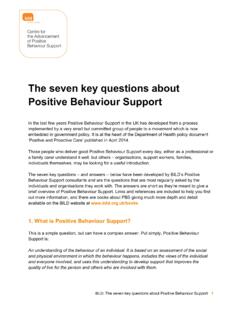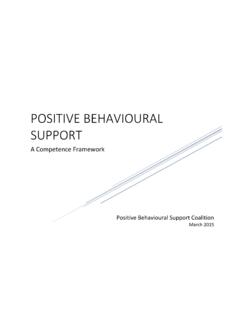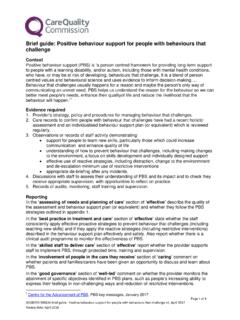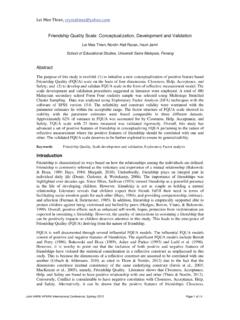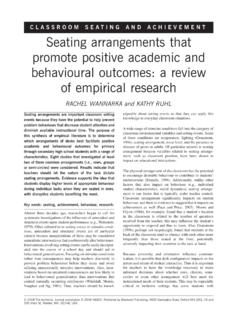Transcription of The relationship between speech, language and ...
1 The relationship between speech, language and communication needs (SLCN) and behavioural, emotional and social difficulties (BESD) Geoff Lindsay1 & Julie Dockrell2 1 CEDAR, University of Warwick 2 Institute of Education, University of London This research report was commissioned before the new UK Government took office on 11 May 2010. As a result the content may not reflect current Government policy and may make reference to the Department for Children, Schools and Families (DCSF) which has now been replaced by the Department for Education (DfE). The views expressed in this report are the authors and do not necessarily reflect those of the Department for Education. 2 Prevalence .. 10 Continuity of BESD over time .. 11 language impairments and BESD .. 11 Other factors .. 12 The report .. 12 Prospective study of pupils with language impairment and autism spectrum disorder.
2 14 Overall prevalence .. 15 Comparison by age .. 15 Autism characteristics .. 16 Emotional and social well-being .. 17 What factors are associated with behavioural, emotional and social difficulties? 18 Classroom behaviour .. 18 Behavioural, emotional and social difficulties in secondary school pupils with SLCN 19 BESD in a clinical sample .. 20 Conclusions .. 22 Data source .. 23 Prevalence of SLCN by age group .. 24 Transition of pupils from SLCN and ASD to other categories of special educational need 26 Characteristics of those that switch SEN category .. 29 Conclusions .. 29 3 Peer relations .. 30 Relationships with teachers .. 33 Meeting social and emotional needs .. 33 Conclusions .. 34 Parents were generally positive about how their children s behavioural, emotional and social needs were being met. The large majority of parents reported that their children had positive reciprocal relationships with their teacher (60% reporting this to be very positive ).
3 Parents of children attending mainstream schools with a designated specialist resource were especially positive . Two thirds of parents of children with language impairment consider their child to have positive peer relationships compared with one third of parents of pupils with ASD.. 34 TOMBLIN, J. B., ZHANG, X., BUCKWALTER, P., & CATTS, H. (2000).THE ASSOCIATION OF READING DISABILITY, BEHAVIOURAL DISORDERS, AND language IMPAIRMENT AMONG SECOND-GRADE CHILDREN. JOURNAL OF CHILD PSYCHOLOGY AND PSYCHIATRY, 41, 473-482. 4 The Better Communication Research Programme (BCRP) was commissioned as part of the Better Communication Action Plan1, the government s response to the Bercow review of services for children and young people with speech, language and communication needs (SLCN). This had recommended a programme of research to enhance the evidence base and inform delivery of better outcomes for children and young people ( )2.
4 This is one of four thematic reports which synthesize the findings from the 10 technical reports that report the results from individual BCRP projects; there are also two interim reports and a report of the BCRP as a whole (see Appendix 1 for full details). Previous research has suggested that pupils with SLCN and those with autism spectrum disorders (ASD) are at greater risk of developing behavioural, emotional and social difficulties (BESD) than typically developing children and young people. However, recent research has indicated that it is important to distinguish different types of speech, language and communication difficulties and also different domains of the generic category BESD. Both policy and practice require a careful analysis of these relationships in order that provision is appropriate to meet individuals needs and that the provision is made effectively and cost effectively.
5 This thematic report draws together evidence from five of the BCRP technical reports to extend our understanding of the needs of and support provided for pupils with SLCN. In this report we examine the relationship between behavioural, emotional and social difficulties (BESD) and SLCN. These studies include three that investigated specific groups of children and young people with SLCN and two that comprised analyses of the national datasets for England, the School Census and the National Pupil Database. Key Findings Children and young people with SLCN and ASD are at increased risk of developing behavioural, emotional and social difficulties but there are different patterns for different domains of BESD. Overall, the main areas of difficulty are the development of successful peer relationships and prosocial behaviour and the risk of developing emotional difficulties. 1 2 Bercow, J.
6 (2008) The Bercow Report: A review of services for children and young people (0-19) with speech, language and communication needs. Nottingham: DCSF. 5 In general, children and young people with ASD have more difficulties than those with SLCN but both groups are at risk. The main implication is that interventions for children and young people with SLCN as well as those with ASD should be planned taking into account their needs as a whole. In addition, in order to develop their language and communication abilities, children and young people with ASD and SLCN require support to develop effective peer relationships and to address emotional difficulties. It is necessary to establish a profile of strengths and weaknesses for each child and young person with SLCN or ASD; to determine and implement an action plan that addresses the profile of needs; and to monitor over time as profiles can change.
7 Diagnostic category is an insufficient indicator of need or of action. Detailed findings Compared with the general population of pupils of their age: The overall level of BESD was significantly higher than the norm for pupils with SLCN and those with ASD than the norm: Pupils with SLCN were more likely to have significant peer problems and emotional difficulties and less developed prosocial behaviour than the general population of the same age. o Levels of peer problems and difficulties with prosocial behaviour were even higher in pupils with ASD than those with SLCN o Levels were higher among older children with language impairment but higher among younger children with ASD. o Unaffected siblings of children and young people with SLCN and ASD also had higher levels of peer problems, indicating that siblings who do not have SLCN or ASD are at risk of difficulties with peer relationships.
8 Prevalence of conduct problems and hyperactivity was also higher than the norm, but less so than the other measures of BESD. Pupils with ASD were, as expected, more likely than pupils with SLCN to exhibit autism characteristics but there was also a higher level of autism characteristics among pupils with SLCN than in the general population. Self-perceived quality of life was worse across a number of domains for pupils with ASD and those with SLCN, in particular difficulties with social acceptance and being bullied, moods and emotions. 6 On other quality of life dimensions pupils with SLCN were significantly more positive than those with ASD: psychological well-being, parent relations and home life, social support and peers, and school environment. This pattern was replicated 12 months later, indicating the persistence of these difficulties; however the perceived quality of life level improved for both the SLCN and ASD groups for moods and emotions, self-perception, and social acceptance/bullying.
9 Children with SLCN and ASD were more likely: o To have impaired social cognition and social communication but not difficulties with structural language abilities ( grammar) o To come from socially disadvantaged backgrounds. Analyses of the national statistics As pupils with special educational needs (SEN) move through the school system their needs are reassessed. Pupils with SLCN or ASD at the end of Key Stage 2 (Year 6), with levels of need at School Action Plus or requiring a statement of SEN, may have their needs redesignated. Our analyses show that: Pupils with SLCN do not have a particularly high risk of being recategorised as having BESD as their primary need after transfer to secondary education. Only 18% of pupils with SLCN but 41% with ASD at School Action Plus (SAP) at the end of Key Stage 2 remained in the SAP category at the end of Key Stage 3. The majority (59%) of pupils with SLCN but only a third of pupils with ASD move out of the School Action Plus category between the end of Key Stage 2 and end of Key Stage 3 into a lower level of need, either School Action or no special educational needs (non-SEN) Of those pupils with SLCN or ASD at School Action Plus who move into another SEN category at School Action Plus between the end of Key Stage 2 and end of Key Stage 3: o Only 7% of pupils originally with SLCN moved into BESD compared with 15% of pupils originally with ASD o More pupils with SLCN (24%) moved into an SEN category concerned with learning difficulties than pupils with ASD: Moderate learning difficulties (MLD): 15% from SLCN, 11% from ASD, Specific learning difficulties (SpLD): 9% from SLCN, 6% from ASD Only 2% of pupils with SLCN move to ASD.
10 7 These patterns were similar for pupils with statements and for the smaller numbers moving between the end of Key Stage 3 and end of Key Stage 4. The characteristics of pupils that switched categories were: o For both pupils with SLCN and those with ASD, moving to another SEN category: Lower attainment at the end of Key Stage 2 o For pupils with SLCN only, moving to a lower level of need (School Action or non-SEN): Having English as an additional language o For pupils with SLCN moving to another SEN category: Attending a more disadvantaged school (one with a high proportion of pupils eligible for a free school meal) Implications Although pupils with ASD are at greater risk of behavioural, emotional and social difficulties, there is a substantial overlap in the behavioural, emotional and social needs of pupils with SLCN and those with ASD. As with pupils with ASD, those with SLCN are at risk of having problems with peer relationships and prosocial skills and of developing emotional problems.










